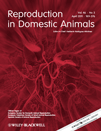View Item
- xmlui.general.dspace_homeCentros Regionales y EEAsCentro Regional Buenos Aires SurEEA BalcarceArtículos científicosxmlui.ArtifactBrowser.ItemViewer.trail
- DSpace Home
- Centros Regionales y EEAs
- Centro Regional Buenos Aires Sur
- EEA Balcarce
- Artículos científicos
- View Item
Histopathological, Immunohistochemical, Lectinhistochemical and Molecular Findings in Spontaneous Bovine Abortions by Campylobacter fetus
Abstract
Bovine campylobacteriosis (BC) is a venereal disease caused by Campylobacter fetus characterized by temporary infertility with mild endometritis, early embryonic death and occasional abortions. The objectives of this study were to describe and identify C. fetus in spontaneous bovine abortion on the basis of histopathological, immunohistochemical, lectinhistochemical and polymerase chain reaction (PCR) techniques. The most frequent foetal lesion was
[ver mas...]
Bovine campylobacteriosis (BC) is a venereal disease caused by Campylobacter fetus characterized by temporary infertility with mild endometritis, early embryonic death and occasional abortions. The objectives of this study were to describe and identify C. fetus in spontaneous bovine abortion on the basis of histopathological, immunohistochemical, lectinhistochemical and polymerase chain reaction (PCR) techniques. The most frequent foetal lesion was neutrophilic bronchopneumonia and interstitial pneumonia. Other commonly observed lesions included non‐suppurative interstitial enteritis, hepatitis, pericarditis, myositis, myocarditis, and meningitis. In this study, C. fetus fetus was phenotypically classified in all bovine foetuses from lungs and abomasal fluids. Immunohistochemistry (IHC) staining revealed positive stained Campylobacter organisms with typical morphology. Lectin binding patterns not showed great differences between the infected and the non‐infected groups. The most important changes were a minor peanut agglutinin (PNA) and DBA binding in the alveolar cells of the lungs and DBA globet cells in some of the C. fetus–positive foetuses. Individual variations in each lectin binding pattern complicate the evaluation of the lectins results. All foetuses positive to IHC were positive by PCR. Better efficiency of PCR was obtained from abomasal fluids than from lung tissues. The association of culture and phenotypic techniques with histopathology, IHC and PCR allowed a better characterization and description of BC.
[Cerrar]

Author
Morrell, Eleonora Lidia;
Barbeito, Claudio Gustavo;
Odeon, Anselmo Carlos;
Gimeno, Eduardo Juan;
Campero, Carlos Manuel;
Fuente
Reproduction in Domestic Animals 46 (2) : 309-315 (April 2011)
Date
2011-04
Editorial
Wiley
ISSN
0936-6768
1439-0531
1439-0531
Formato
pdf
Tipo de documento
artículo
Palabras Claves
Derechos de acceso
Restringido
 Excepto donde se diga explicitamente, este item se publica bajo la siguiente descripción: Creative Commons Attribution-NonCommercial-ShareAlike 2.5 Unported (CC BY-NC-SA 2.5)
Excepto donde se diga explicitamente, este item se publica bajo la siguiente descripción: Creative Commons Attribution-NonCommercial-ShareAlike 2.5 Unported (CC BY-NC-SA 2.5)

